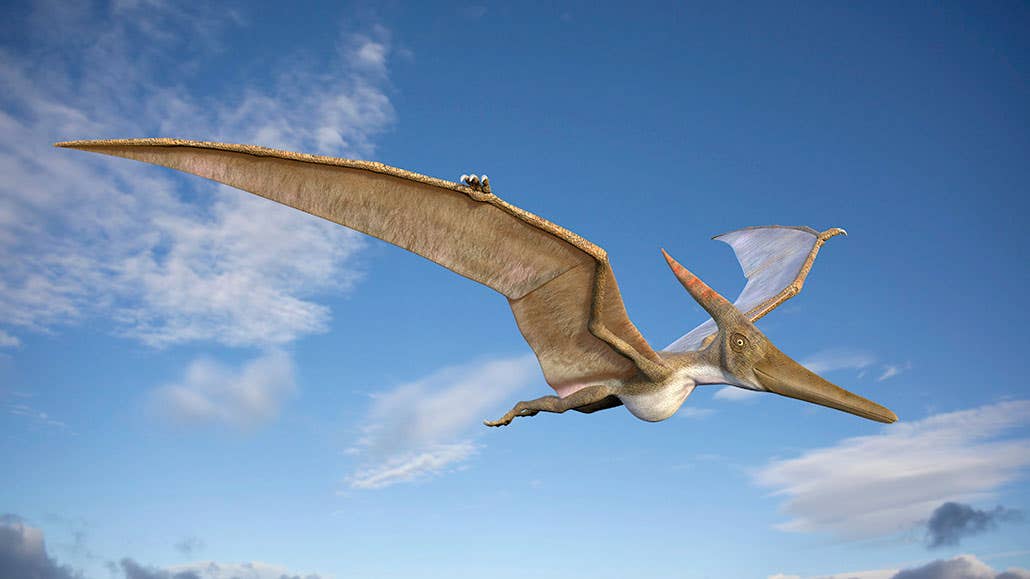New fossil discovery reveals the origins of flying reptiles
Skiphosoura bavarica, a newly discovered Jurassic pterosaur, reveals key evolutionary transitions from early reptiles to advanced pterodactyloids.

Skiphosoura bavarica, a newly discovered Jurassic pterosaur. (CREDIT: Roger Harris/Science Photo Library/Getty Images)
Skiphosoura bavarica, a newly discovered Jurassic-era pterosaur, has reshaped our understanding of the evolutionary trajectory of these ancient flying reptiles. Found in southern Germany, this fossil bridges a key gap in the progression from early pterosaurs to the more advanced pterodactyloids, offering a clearer picture of their gradual anatomical transformations.
Pterosaurs, close relatives of dinosaurs, were the first vertebrates to master powered flight. Early species were modest in size, with wingspans of about 2 meters. Over millions of years, some evolved into giants with wingspans reaching up to 10 meters. Understanding how this remarkable evolution unfolded has long posed a challenge for paleontologists.
Discovered in 2015 in the Schaudiberg Quarry near Mühlheim, Bavaria, Skiphosoura was preserved in three dimensions—a rarity among pterosaur fossils, which are often flattened during fossilization.
This almost-complete skeleton revealed a wingspan of approximately 2 meters and a distinctive short, stiff, sword-like tail. This unusual tail inspired its name, derived from the Ancient Greek words for "sword" and "tail."
The findings, published in Current Biology, were led by Dr. David Hone of Queen Mary University of London. According to Hone, "This is an incredible find. It really helps us piece together how these amazing flying animals lived and evolved. Hopefully, this study will inspire more research into this important evolutionary transition."
For nearly two centuries, scientists divided pterosaurs into two primary groups: early non-pterodactyloids, characterized by small heads, long tails, and specific wing and foot adaptations, and the later pterodactyloids, which exhibited larger heads, shorter tails, and modifications suited for more efficient flight.
Intermediate forms like Darwinopterus, identified in the 2010s, showed that head and neck changes occurred before other major adaptations. Skiphosoura adds another crucial piece to this evolutionary puzzle.
Skiphosoura’s anatomy blends traits from both early and advanced pterosaurs. Its head and neck resemble those of pterodactyloids, yet its wrist, tail, and foot retain features of earlier forms. This unique combination illustrates the gradual transitions that enabled later pterosaurs to grow in size and thrive in diverse environments.
Related Stories
To further contextualize this discovery, the research team reconstructed the evolutionary family tree of pterosaurs. Skiphosoura occupies a position between Darwinopterus and true pterodactyloids, helping to complete a near-seamless evolutionary sequence.
Additionally, a Scottish pterosaur named Dearc serves as a critical link between early pterosaurs and Darwinopterus. Together, these findings map the incremental changes in pterosaur anatomy over time.
Skiphosoura's discovery underscores the importance of collaborative efforts in advancing paleontological research. The fossil was carefully prepared by Stefan Selzer, an expert who has worked on over 60 pterosaur specimens from the Solnhofen limestone.
“It became clear during preparation that this fossil displayed features from both major groups of pterosaurs, with the shortened tail being a crucial diagnostic trait,” Selzer noted.
The project also benefited from modern imaging techniques such as ultraviolet photography, which revealed fine anatomical details. Bruce and René Lauer of the Lauer Foundation, who supported the research, emphasized the role of these advanced methods. “We are proud to bring this important specimen to science and further the understanding of pterosaur evolution,” said Bruce Lauer.
The geological context of Skiphosoura’s discovery adds further significance. The fossil was unearthed in the Mörnsheim Formation, a series of laminated limestones dating to the Late Jurassic period, roughly 150 million years ago. This region has yielded numerous important fossils, shedding light on the diverse ecosystems of that era.
The evolutionary progression traced in this study highlights specific trends among pterosaurs. Gradual increases in head size and neck length, along with elongation of the wing metacarpal, supported improved aerodynamics and terrestrial mobility.
At the same time, reductions in tail length and complexity reflect adaptations for more advanced flight dynamics. These changes paved the way for the massive, highly specialized pterodactyloids that dominated later periods.
Adam Fitch, a researcher at the University of Wisconsin-Madison, emphasized the broader implications of these findings. “Pterosaurs have long been symbols of the unique life of the past. Skiphosoura represents an important new form for working out pterosaur evolutionary relationships and how this lineage arose and changed."
Skiphosoura bavarica not only provides a rare glimpse into the life of Jurassic pterosaurs but also demonstrates the power of combining meticulous fossil preparation with cutting-edge analytical methods.
By filling a crucial gap in the evolutionary record, it brings us closer to understanding the origins of one of Earth’s most extraordinary groups of flying vertebrates.
Note: Materials provided above by The Brighter Side of News. Content may be edited for style and length.
Like these kind of feel good stories? Get The Brighter Side of News' newsletter.
Rebecca Shavit
Science & Technology Journalist | Innovation Storyteller
Based in Los Angeles, Rebecca Shavit is a dedicated science and technology journalist who writes for The Brighter Side of News, an online publication committed to highlighting positive and transformative stories from around the world. With a passion for uncovering groundbreaking discoveries and innovations, she brings to light the scientific advancements shaping a better future. Her reporting spans a wide range of topics, from cutting-edge medical breakthroughs and artificial intelligence to green technology and space exploration. With a keen ability to translate complex concepts into engaging and accessible stories, she makes science and innovation relatable to a broad audience.



